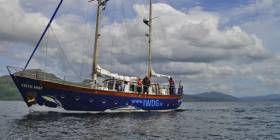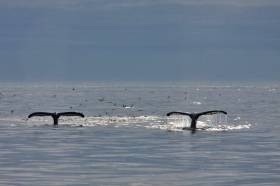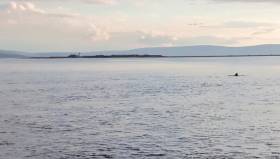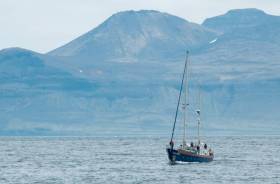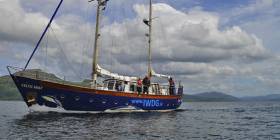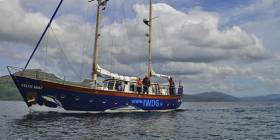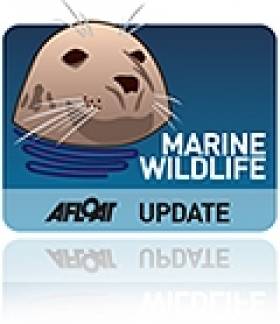Displaying items by tag: Celtic Mist
Maintaining Charlie Haughey's Celtic Mist
Ten years ago the family of Charlie Haughey offloaded their yacht, Celtic Mist, to the Irish Whale and Dolphin Group.
It took most of a year to refurbish it and the cost was put at around €80,000.
The yacht was getting "old and tired and needed rejuvenation," it was stated.
The family said they had great memories of good times aboard, but it was too big for them anymore.
I was invited to do the 'honours' at the relaunch of Celtic Mist at Kilrush Marina on the Shannon Estuary.
Most of the "rejuvenation work" had been done in Kilrush by a mix of volunteers and professionals. I agonised over what to say. For a journalist, there were obvious difficulties, so I approached the event from a predominantly maritime viewpoint – the restoration to a working life of a boat in her proper location – in the water.
 Charlie Haughey onboard Celtic Mist
Charlie Haughey onboard Celtic Mist
I did have reasonably good relations with Mr Haughey when I became a marine correspondent, as different to my former journalistic incarnation as a news reporter. In the context of our mutual maritime interest, we had discussed the marine sphere, and I was the recipient of friendly Christmas cards. However, it was still an occasion to be treated with great care. In fact, the main interest amongst the public attendance seemed to be to get the opportunity to go aboard and see whether there was, as had been widely reported, a bath attached to Charlie's cabin. In fact, it had been removed during the refurbishment!
 Celtic Mist in her new livery
Celtic Mist in her new livery
Since that event, I've been bound with an interest in the voyages of Celtic Mist and am impressed by her new livery in which she has emerged from her latest treatment at Howth Boatyard. She has been on 'shakedown survey work' prior to her annual hosting of members of the IWDG who will be doing more marine wildlife surveys.
The Group's Chief Executive has been telling me about the current state of the yacht and the plans for this year as my guest on this week's Podcast.
Listen to the Podcast here.
A group of Ireland’s environmental NGOs are teaming up this spring for a rather unique education project lead by the Irish Whale and Dolphin Group. The exciting Floating Classroom initiative is combining ocean exploration with an educational schools programme which aims to raise awareness of Ireland’s marine biodiversity. Taking to the seas in the IWDG’s research vessel Celtic Mist, the team of marine biologists and ocean literacy experts will be making their way down Ireland’s south-east coast from Arklow to Cork, calling into coastal communities providing engaging workshops to schools along the way.
After an extensive refit during the winter in Grand Canal Docks, Dublin, the 56-foot ketch yacht will also be open to the public when docked at local marinas and harbours, giving the public an opportunity to see the workings of a dedicated whale and dolphin research vessel and how researchers live and work at sea.
Apart from raising awareness for Ireland’s rich marine wildlife, the team will be emphasising the importance of taking care of our seas and oceans. With challenges such as plastics pollution, climate change and biodiversity loss now frequently in the news, there is a pressing need for communities to work together to tackle environmental issues.
While pupils will be introduced to the wealth of marine and coastal wildlife on their doorstep, each school will be asked to come up with three ways in which they feel they can make a difference for their local blue environment.
The team of biologists will also be proposing ways in which the public can get involved, including citizen science projects that encourage people to report their sightings of whales, dolphins, seabirds and even shark eggs! Schools will be encouraged to get involved in other community-based initiatives too, such as beach cleans being run by organisations in their area.
Environmental NGOs involved in the Floating Classroom include the Irish Whale and Dolphin Group, Marine Dimensions, the Irish Wildlife Trust and the Irish Ocean Literacy Network. Funding for the Floating Classroom has been kindly received by the Irish Environmental Network through their Capacity Building Grant.
Irish Whale & Dolphin Group Continues Its ‘Trail Of The Whale’ Library Tour Across The Country
The Irish Whale and Dolphin Group (IWDG) is bringing stories from the Celtic Mist’s historic marine wildlife survey voyage around Iceland to libraries and other venues nationwide.
Already the IWDG has visited 10 venues across eight counties in its ‘On the Trail of the Whale’ tour, which continues tonight (Tuesday 19 February) at 7pm in Killarney Library.
In May last year a crew of marine scientists and enthusiasts set sail on the IWDG’s research yacht for a weeks-long return passage to the edge of the Arctic Circle in search of humpback whales, building “strong links with Iceland and its people” along the way.
Last month, IWDG members began sharing their experiences from the rewarding mission in images, stories and video of the voyage to audiences in libraries and other venues across the island of Ireland — beginning on 14 January at DLR LexIcon and since visiting Galway, Tralee, Monaghan town and Arklow, as well as Bangor and Warrenpoint in Northern Ireland and Dublin’s Poolbeg Yacht Club.
“Through the tour, we want to encourage people to get involved,” IWDG’s chief science officer Dr Simon Berrow told the Irish Examiner. “If even one person at every event we do gets interested [in marine life] and gets motivated, that’s fantastic.”
The Irish Examiner has much more on the story HERE.
Galway’s Dolphin Nimmo Returns To City Waters
#MarineWildlife - Galway residents have a great opportunity to see a wild dolphin close to the city centre with the return of regular visitor to the Nimmo’s Pier area this week.
Nicknamed Nimmo, the solitary bottlenose dolphin was first sighted in the city in April 2015 and since then has become an annual fixture, appearing and staying longer each time.
The Irish Whale and Dolphin Group (IWDG) suggests this is a sign that the area around Galway city is now a “more important core feeding habitat for Nimmo”.
In other news, the IWDG’s research vessel Celtic Mist will embark on a series of week-long surveys this summer in search of humpback whales.
IWDG members are invited to join any of the nine legs, the first of which sets sail from 9-15 June (weather permitting) between Cork and Dingle/Fenit.
For details on how to book a place on any of these voyages and for further information, contact [email protected].
'Celtic Mist' Voyage to Iceland to be Recounted in Irish Whale & Dolphin Lecture Tour
To celebrate the recent Irish Whale and Dolphin Group (IWDG) expedition to Iceland in May-July 2018 onboard Celtic Mist, the IWDG will be undertaking a tour of Ireland to share stories, images and videos of this exciting and challenging marine wildlife expedition which circumnavigated 1500 nautical miles of the North Atlantic.
The tour launches on January 14th 7-8: 30 pm at The Lexicon, Dun Laoghaire, Dublin. All events are free and open to everyone.
“It was a wonderful privilege to visit this beautiful country again and to see it from the sea on board Celtic Mist and to have an opportunity to explore the extremity of our humpbacks northern range with a nice mix of whale researchers, enthusiasts, IWDG personnel and sailors” said Pádraig Whooley.
Four women and four men; a retired school teacher, a surgeon, a parks ranger, two IT specialists and with a farmer from Kildare were onboard and skippered by a project manager from Arklow.
During the next six weeks, 30 members from the Irish Whale and Dolphin Group, of all ages and all walks of life sailed Celtic Mist 4,500 km around the Icelandic coast and even into the Arctic Circle before returning her back to Dublin via the Faroe Islands and Scotland.
They went in search of humpback whales, one of the most enigmatic species in the world’s oceans. Humpback whales are increasing in Irish waters and the Irish Whale and Dolphin Group wanted to know where are they coming from or going to! Ireland and Iceland share this whale population and we wanted to improve knowledge and build relationships between our two island nations. But they came back with more than they bargained for!
Many experiences were shared by those who sailed Celtic Mist on this ambitious expedition. Many special moments were had with people and wildlife that will stay with these everyday mariners for the rest of their days.
A collection of images and videos will be presented, by the skippers, scientists and crew who ventured on the “trail of the whale”.
“The journey from Iceland was at times challenging but overall very rewarding, with stop-offs in the Faroes and Scotland, which pale in comparison to the beauty of Iceland. Altogether an amazing experience with effects that will reverberate for years to come”, said crew member Loraine Smith.
The day we sat for hours amongst several groups of humpbacks as they fed. The day we sat in the mist in the high sub-arctic and watched a blue whale mother and calf circle the boat.
The day we crept quietly deep into a fjord, passing old whaling stations, and were serenaded by a cacophony of birdlife.
The morning we woke in another fjord to see an arctic fox foraging metres from our anchorage.
“Four humpback whales in a feeding frenzy at the entrance to Eyjafjörður on our way from Siglufjörður to Dalvík. Their primitive sounds and actions oblivious to Celtic Mist drifting in their midst. The blue whale mother and calf that we encountered between Grimsey and Húsavik. Again we drifted without the engine and they circled us at a safe distance. A magical and sensitive moment not to be forgotten”, Mick O’Meara, Skipper.
Download the poster below
#CelticMist - The Celtic Mist’s historic marine wildlife survey voyage to Iceland is complete, with the Irish Whale and Dolphin Group (IWDG) recording nearly 100 sightings over the course of the month.
The research yacht set sail with a crew of wildlife enthusiasts and marine scientists in late May for the 2018 IWDG Humpback Whale Expedition, taking less than a week to cross the North Atlantic to the edge of the Arctic Circle.
Week one began on 31 May on arrival at Vestmannaeyjar in the south, following a clockwise route round to Reykjavik — minke whales, humpbacks and dolphins recorded along the way.
Though sightings were slim in number, the Celtic Mist team hailed “great engagement with both Icelandic people and people from overseas working in Iceland”.
“From the Marine and Freshwater Research Institute to tour operators and guides and visiting scientists, all have given us insights into life in Iceland and whaling and whale-watching issues,” said the IWDG’s Simon Berrow.
Week two was spent amid poor conditions in Iceland’s remote West Fjords — with sea ice and stormy weather keeping the Celtic Mist firmly in part at Isafjordur for the first few days.
But later in the week, patience was rewarded with the sighting of five humpback whales, the majority of a group known to the area but never recorded further south-east in Irish waters.
Week three brought a crew change and a break in the weather allowing passage to the north-west peninsula of Hornstrandir — still a challenge with rolling seas overnight.
“In almost 21 hours of sailing in some of the most productive waters on the planet and in reasonable viewing conditions and 24 hours daylight, we didn’t have a single cetacean sighting,” remarked IWDG sightings officer Pádraig Wholley.
“It would be inconceivable that Celtic Mist would survey for a whole day in Irish waters without a single sighting entry being input into the logger software that we were running throughout.
“This was our first strong evidence that if you want to find marine mammals in Icelandic waters, that open waters may not be the place to be looking.”
Week four took the IWDG to the “poorly surveyed” East Fjords, via the Arctic Circle — in bright midnight sun instead of the common sea fogs. Sightings remained consistent, with no big whales spotted on Iceland’s eastern coast.
The Celtic Mist was due back in Ireland by tomorrow (Friday 13 July) when the mammoth task of sorting through all the recorded data and images begins.
But perhaps the greatest takeaway the voyage is in the connections made with Icelanders around their coastline, suggests Berrow.
“We have achieved all our objectives and built strong links with Iceland and its people. We have discussed fishing, whaling, whale watching and the weather.
“We have a great appreciation of these issues and the differing perspectives and challenges faced which ultimately will be decided by Icelanders.”
#CelticMist - Join the Irish Whale and Dolphin Group at Dublin’s Grand Canal Dock this Sunday 20 May to celebrate before its research vessel Celtic Mist embarks on a historic marine wildlifearine wildlife expedition to Iceland.
As Coast Monkey reports, visitors on the afternoon from 2pm-5pm will have the opportunity to chat with the crew and marine scientists taking part in the 2018 IWDG Humpback Whale Expedition, as well as take a tour of the Celtic Mist before its final fitting in Donegal.
#HelpCetaceans - From the fast and furious ThunderCats to the more serious side of marine wildlife as the Irish Whale & Dolphin ketch is part of the Dublin Riverfest which concludes this afternoon, writes Jehan Ashmore.
As previously reported on Afloat, the IW&DG’s research vessel, the RV Celtic Mist is open to the public from among the visiting tallships. The 56ft steel hulled ketch is berthed in the Grand Canal Dock Basin. It is refreshing to see that the ketch has occupied a berth at this location to spread the maritime festival beyond the Liffey quays.
Celtic Mist with a port of registry in the capital is berthed in the dock basin close to the Plaza opposite the Bord Gáis Energy Theatre. The ketch in recent years was donated by the family of the late Charles J. Haughey.
The former Taoiseach having declared Ireland as a whale and dolphin sanctuary in 1991, however the IW&DG are appealing for donations and corporate sponsorship to ensure the financial sustainability of running the ketch within the next three years. They require €20,000-30,000 to operate the costs of the ketch based on an annual basis.
Afloat took the opportunity to board the handsome looking French built ketch dating to 1974 and now carrying out important research on cetaceans. The work by the IW&DG is invaluable, given the all-Ireland group is dedicated to the conservation and better understanding of whales, dolphins and porpoises.
This involves Celtic Mist undertaking cruises to monitor species off our shores and by returning such data that leads to further studies, education and interpretation. These cruises (up to eight persons) carry out sighting of cetaceans and involves co-ordination schemes when species are stranded.
In addition to the role of Celtic Mist, assistance in carrying out sightings involves ferry and aerial surveys with the collaboration of the Air Corps Maritime Squadron. The combination of all such data is to help monitor the status of whales and dolphins in Ireland and to inform policy and implementation of action plans.
For more on the work of the IW&DG and how to become a member if you are to sail on the RV Celtic Mist, visit their website here.
#MarineWildlife - Places are going fast for a special cruise on board the Irish Whale and Dolphin Group's Celtic Mist to celebrate the 25th anniversary of Ireland's whale and dolphin sanctuary.
Celtic Mist will depart Fenit, Co Kerry next Saturday 7 May with a team of IWDG members and marine science experts on an almost three-month circumnavigation of Ireland, first heading north along the Wild Atlantic Way and around to the Irish Sea, calling on Dublin on 7 June to mark the 25th anniversary of the Irish Government's official declaration of this island's waters as a sanctuary for cetaceans.
The declaration came only three months after it was proposed by the then newly formed IWDG, and both have been instrumental in raising awareness of the bounty of marine wildlife in Irish waters.
Though berths on the voyage are filling fast, everyone will have the opportunity to participate by assisting in outreach events along the cruise route, or by tracking its progress online. Details on how to get involved can be found on the IWDG website HERE.
Along the way passengers on Celtic Mist may be treated to some of the incredible wildlife the sanctuary was created to protect, such as humpback whales – a number of which were spotted on an early visit to West Kerry earlier this month, likely attracted by schools of sand eels, as the IWDG reports.
In other marine wildlife news, locals near a beach close to Ballyshannon in Co Donegal have complained after a whale carcass was left rotting on rocks three days after it was reported to authorities.
According to the Irish Mirror, successive high tides had failed to shift the 25ft minke whale, though Donegal County Council says it is arranging for the animal's disposal.
BBC Crew Film Humpback Whale Off Skelligs
#MarineWildlife - Ireland is "one of the best locations on the northern hemisphere" to film marine wildlife in action, according to RTÉ News.
The statement comes from the Irish Whale and Dolphin Group's (IWDG) Pádraig Whooley, who recently returned from a trip off Kerry on board the organisation's research vessel Celtic Mist with a camera crew from the BBC's Natural History Unit.
Their mission, in planning for a year, was to film humpback whales – and by their second day on the water, past the Skelligs, they came upon heir first specimen, #HBIRL23, a "big-winged New Englander" who has been spotted around the Blaskets and Skelligs a number of times since May this year.
"Not only did we capture some magical moments with this animal in a stunning location, often breaching and fluking with the Skelligs in the background to our west, but this re-sighting is another important piece of information regarding the movements of humpback whales visiting the Irish Southwest," said Whooley, the IWDG's sightings officer.
What's more, the sighting last week was surely a good omen for yesterday's Whale Watch Ireland event across 20 mainland vantage points around Ireland's coast.
The IWDG website has much more on the story HERE.


























